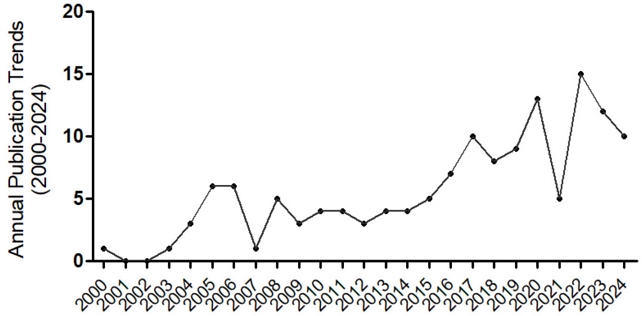
Investigating Qi-Centered Interventions for Neurodegenerative Disorders: Trends in Patents and Academic Literature
Ⓒ The Korean Environmental Sciences Society. All rights reserved.
This is an Open-Access article distributed under the terms of the Creative Commons Attribution Non-Commercial License (http://creativecommons.org/licenses/by-nc/3.0) which permits unrestricted non-commercial use, distribution, and reproduction in any medium, provided the original work is properly cited.
Abstract
This study explored the intersection of environmental stressors—such as pollutants and toxins—with mitochondrial dysfunction in neurodegenerative diseases, including Parkinson’s and Alzheimer’s. Mitochondrial dysfunction, exacerbated by environmental factors, plays a significant role in the progression of these diseases. The study investigates the potential of Qi (氣)-based therapeutic interventions by analyzing global trends in patent filings and academic literature. In traditional East Asian medicine, Qi is considered a vital force that regulates bodily balance and vitality. Recent interdisciplinary research has begun to integrate this concept with modern mitochondrial biology, suggesting that Qi correlates with bioenergetic processes—particularly those involving the mitochondria, which are responsible for cellular energy production and regulation of oxidative stress. This study highlights how traditional medicinal substances such as ginseng, licorice, and angelica can enhance mitochondrial function and potentially slow the progression of neurodegenerative diseases. Patent analysis reveals that South Korea is at the forefront of research on Qi-based treatments, with a marked increase in patent filings in recent years. These findings support the hypothesis that Qi-based therapies, through their modulation of mitochondrial function, may offer significant complementary or integrative approaches for treating neurodegenerative diseases, particularly those induced by environmental stressors. Further research is necessary to understand the mechanism by which Qi influences mitochondrial function in the context of environmental factors, to optimize these therapies for clinical application.
Keywords:
Neurodegenerative disorders, Qi, Patent analysis, Mitochondria, Academic literature1. Introduction
Mitochondria play a central role in cellular energy production by generating adenosine triphosphate (ATP), which is essential for maintaining biological homeostasis and sustaining life (Casanova et al., 2023). At the same time, mitochondria are highly sensitive to external environmental factors, including heavy metals, air pollutants, pesticides, and fine particulate matter (Casanova et al., 2023). These environmental stressors can impair mitochondrial function, leading to oxidative damage, cellular dysfunction, and accelerated neurodegeneration. Notably, mitochondrial dysfunction caused by such stressors has been implicated in the pathogenesis of several neurodegenerative brain diseases, including Alzheimer’s disease and Parkinson’s disease (Luo et al., 2022).
Neurodegenerative brain diseases are typically characterized by the progressive loss of specific neuronal populations, accompanied by chronic oxidative stress, impaired mitochondrial bioenergetics, and dysregulated autophagy (Cunnane et al., 2020). Given the central role of mitochondria in neuronal survival and function, therapeutic strategies aimed at preserving or restoring mitochondrial health have become a critical focus in the effort to prevent or slow the progression of these diseases (Cunnane et al., 2020).
From a complementary perspective, traditional East Asian medicine has long emphasized the concept of Qi (氣) as a fundamental life force that governs vitality, physiological equilibrium, and systemic resilience (Birch et al., 2022). Recent interdisciplinary research has attempted to interpret Qi through a scientific lens, suggesting that it may correspond to cellular bioenergetic processes, particularly those governed by mitochondrial function (Lin et al., 2014; Kang et al., 2020). This modern reinterpretation of Qi opens up novel possibilities for integrating traditional energetic medicine with contemporary biomedical science (Lin et al., 2014).
In this context, Qi-based therapeutic strategies may enhance mitochondrial function, reduce oxidative stress, and support cellular homeostasis, thereby bolstering the nervous system’s ability to withstand environmental insults (Lin et al., 2014; Luo et al., 2022). In neurodegenerative brain diseases—where both aging and environmental factors contribute significantly to disease onset and progression—these strategies may offer meaningful complementary or integrative therapeutic approaches (Luo et al., 2022).
Efforts to translate these concepts into practical applications have resulted in a growing body of research outputs, including patents and academic publications. Therefore, a combined analysis of both patents and scientific literature provides a comprehensive perspective on conceptual developments and emerging innovations in this domain. This study aims to identify and analyze global trends in patents and publications related to Qi-based therapeutic strategies for neurodegenerative diseases. In particular, we explore how such strategies may regulate mitochondrial function in neurons, and assess their potential as integrative interventions for mitigating environmentally induced mitochondrial dysfunction. Through this lens, we aim to evaluate the scientific, technological, and environmental health significance of traditional medical knowledge in addressing challenges in neurodegenerative disease research.
2. Materials and Methods
2.1. Patent analysis
We conducted a systematic search of global patent databases including WIPO (PATENTSCOPE), the United States Patent and Trademark Office (USPTO), the European Patent Office (EPO), and the Korean Intellectual Property Office (KIPO). The search period covered patents published between January 2000 and December 2024. Keywords used in the search are listed (Table 1).
Patents were selected based on the following inclusion criteria:
- (1) The patent must relate to therapeutic strategies or technologies addressing neurodegenerative brain diseases.
- (2) The patent must include references to Qi-based principles or traditional East Asian medical practices.
- (3) The patent should describe mechanisms involving mitochondrial function, bioenergetics, or oxidative stress regulation.
Patents unrelated to therapeutic applications or lacking relevance to mitochondrial biology were excluded.
A patent search was conducted with the objective of identifying and developing functional material technologies effective for Parkinson’s disease and neurodegenerative brain diseases through the activation of Qi. Keywords such as “neurodegenerative brain diseases”, “mitochondria”, and “plant extracts” were expanded to form search terms, and a search query was constructed based on the selected keywords.
To increase the sensitivity of the patent search results, a validity check was conducted to select relevant data. Patents that did not involve “products manufactured using traditional medicine or natural extracts” were excluded from the valid dataset. As a result, out of the initially retrieved 1,865 patents, 385 patents were selected as valid based on the established criteria.
In addition to quantitative classification, selected high-impact patents were further examined to explore how traditional concepts such as Qi are scientifically framed in relation to mitochondrial health. Textual content in the claims and specifications was reviewed to assess conceptual integration, scientific rationales, and therapeutic innovation.
2.2. Literature analysis
In this search, academic publications from all countries published up to December 31, 2024 were included. The databases used for the search were Scopus and PubMed (Table 2).
3. Results
3.1. Analysis by filing country and application trends
Valid patents were analyzed based on filing year and country. In the case of patents related to the discovery and development of functional materials effective for Parkinson’s disease and neurodegenerative brain diseases through the activation of Qi, Korea showed a gradual increase in patent filings starting in the early 2000s, reaching a peak in the 2010s (Fig. 1). Since then, the number of filings has fluctuated but remains consistently high. Japan also maintained a steady level of filings from the 2000s to the present, although the overall number of applications remains relatively low. China recorded the highest number of filings in the 2010s; however, it has shown a gradual decline in recent years. The number of filings in the United States, Europe, and through the PCT system remains generally lower than in Korea and China. This trend may be attributed to the relatively lower interest in traditional East Asian medicine in Western countries compared to East Asia, where such traditions are more deeply rooted. It is also worth noting that the use of the specific IPC classification A61K-036, which refers to materials derived from natural products or traditional medicine, likely contributed to the concentration of filings in Korea and China.
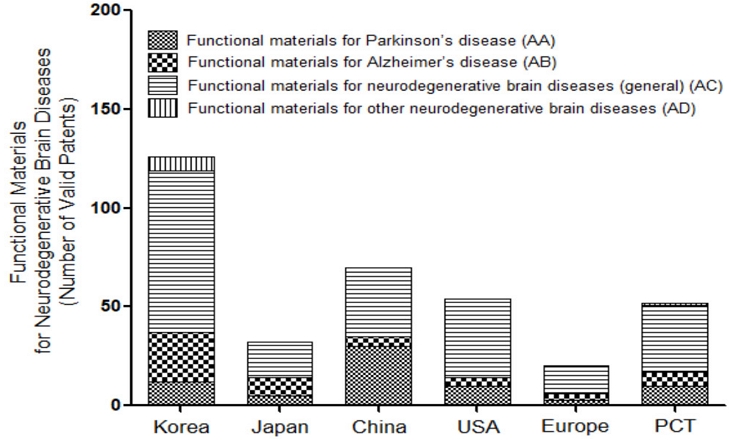
Number of valid patents related to functional materials for neurodegenerative brain diseases. The bars represent the total number of valid patents filed by country, categorized by disease focus: Parkinson's disease (AA), Alzheimer's disease (AB), general neurodegenerative brain diseases (AC), and other neurodegenerative brain diseases (AD). Countries shown include Korea, Japan, China, USA, Europe, and the PCT system.
3.2. Analysis of patent applicants
An analysis of the top seven patent applicants in the field of natural functional materials effective for Parkinson’s disease and other neurodegenerative brain diseases revealed that Kyung Hee University in Korea ranked first overall (Fig. 2). Lanzhou University in China ranked sixth, while the majority of top applicants were Korean institutions. Kyung Hee University and several other Korean institutions were found to have filed a large number of patents related to neurodegenerative brain diseases, including both Parkinson’s and Alzheimer’s disease. In addition, the Korea Research Institute of Bioscience and Biotechnology (KRIBB) had a high number of filings related to other neurodegenerative conditions such as stroke, Huntington’s disease, thrombosis, and various brain disorders.
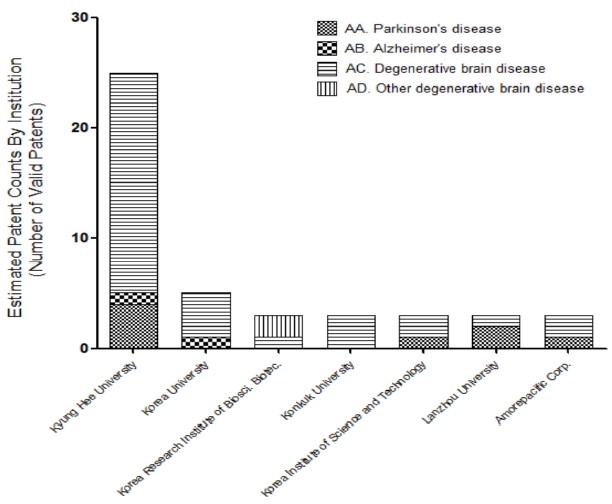
Estimated patent counts by institution for neurodegenerative brain diseases. The bars represent the number of valid patents filed by different institutions, categorized by disease focus: Parkinson's disease (AA), Alzheimer's disease (AB), general neurodegenerative brain diseases (AC), and other neurodegenerative brain diseases (AD). Institutions included are Kyung Hee University, Korea University, Korea Research Institute of Bioscience and Biotechnology (KRIBB), Korea Institute of Science and Technology (KIST), Lanzhou University, and others.
3.3. Analysis by technical subcategory
The analysis of valid patents by technical subcategory showed that the majority, 56%, were related to functional materials targeting general neurodegenerative brain diseases (AC), which often include both Alzheimer’s disease and Parkinson’s disease (Fig. 3). This was followed by 26% of patents specifically focused on Parkinson’s disease (AA) and 14% related to Alzheimer’s disease (AB). A small proportion, 4%, addressed other neurodegenerative brain diseases (AD). These results indicate that many traditional medicine-based functional materials are designed to address multiple neurological conditions, rather than being limited to a single disease. This could indicate a strategic approach to patent filings, where applicants aim to broaden protection by covering multiple disease indications in a single application.
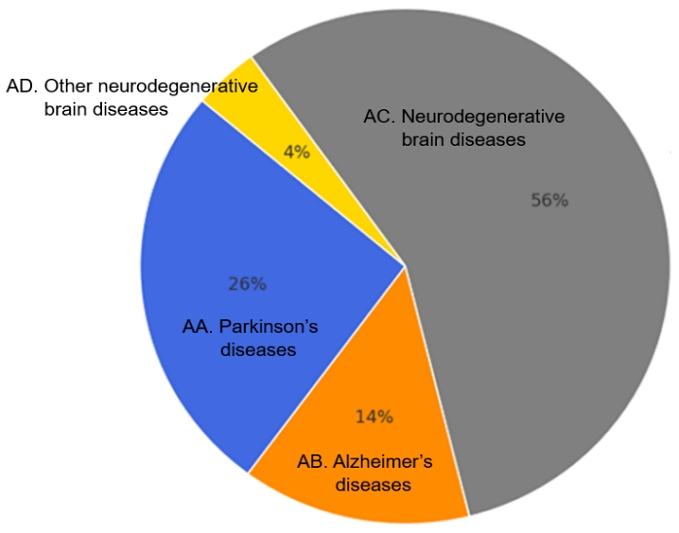
Distribution of patents by type of neurodegenerative disease. The pie chart shows the proportion of patents related to different neurodegenerative diseases: Parkinson's disease (AA) accounts for 26%, Alzheimer's disease (AB) represents 14%, general neurodegenerative brain diseases (AC) make up 56%, and other neurodegenerative brain diseases (AD) account for 4%.
3.4. In-depth patent analysis
Through an in-depth patent analysis, a selection of top functional materials with effectiveness against degenerative diseases was made (Supplementary Table 1). A total of 243 potential functional materials were identified, with ginseng emerging as the most frequently patented material, accounting for 17 patent filings. Ginseng appeared in 17 patent filings, making it the most frequently patented material. Although specific types were not always distinguished, red ginseng and Sanqi are commonly used in such formulations. Licorice followed with 9 filings, angelica and Cnidium with 8 each, and scutellaria with 7. These natural materials are widely used in traditional Korean medicine, indicating their significant therapeutic potential.
3.5. Matrix analysis of 14 selected top functional materials
Based on the patent analysis, a matrix analysis was conducted on 14 selected top functional materials (Supplementary Table 2). The matrix method is used to systematically compare and analyze patent data by arranging various patent details into rows and columns. This method facilitates identifying patterns or relationships between patents. The matrix analysis particularly highlights whether the patents include examples of "mitochondria/ATP activation," allowing easy identification of research related to mitochondrial and ATP activation in these functional materials. This approach provides an organized way to examine the impact of these materials on degenerative diseases, focusing on mitochondrial and ATP activation.
3.6. Analysis of trends in academic papers by year
The literature search was limited to studies on functional materials related to mitochondria and Qi that are effective for neurodegenerative brain diseases (Fig. 4). Since the early 2000s, research on functional materials targeting neurodegenerative diseases has shown a steady trend, and a notable increase in related publications has been observed over the past five years.
3.7. Analysis of paper publication trends by country
The trends in paper publications by country were analyzed based on the institutions publishing the papers with 139 papers. The results showed that China had the highest number of publications, with 64 papers, followed by South Korea, Hong Kong, and other Asian countries (Fig. 5). This is believed to be due to the fact that, similar to patents, Western countries such as the United States and Europe have relatively lower research on natural substances like herbs as therapeutic agents compared to Asian countries.
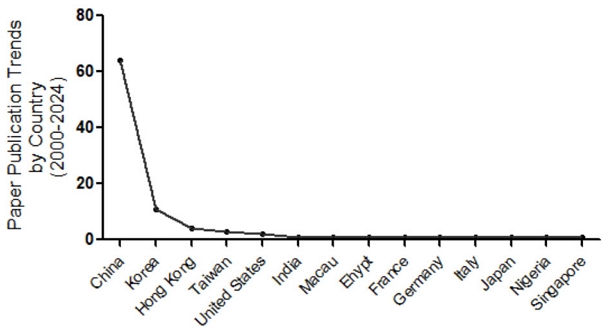
Paper publication trends by country related to Qi-based therapeutic interventions for neurodegenerative brain diseases from 2000 to 2024. The graph highlights China as the leading contributor, followed by Korea and other countries, with relatively fewer publications from the United States and European countries.
3.8. In-depth analysis of papers
From the valid literature, specific papers were selected that studied the effects of functional materials on degenerative brain diseases, including Parkinson’s disease, through measurements of mitochondria or ATP (Supplementary Table 3). These studies help illustrate the therapeutic effects of various materials on mitochondrial function and ATP production, further supporting their potential in the treatment of neurodegenerative diseases. The selected studies are detailed in the following table.
4. Discussion
This study explores the growing interest in Qi-based therapeutic interventions for neurodegenerative brain diseases, including Parkinson's disease and Alzheimer's disease. By integrating the concept of Qi from traditional East Asian medicine with modern mitochondrial biology, this approach offers new therapeutic possibilities for these conditions. Mitochondria are crucial for cellular energy production, while Qi plays a key role in maintaining bodily vitality and balance (Chen et al., 2020; Luo et al., 2024). Both share similar roles in maintaining metabolic balance and cellular defense. Mitochondria contribute by regulating oxidative stress and removing damaged cellular components, while Qi, in the context of traditional East Asian medicine, is understood to support systemic homeostasis and resilience against external stressors, including environmental pathogens (Luo et al., 2024).
Patent and literature analyses indicate that Qi-based strategies targeting mitochondrial function are gaining interest in the treatment of neurodegenerative diseases, particularly those induced by environmental stressors (Chen et al., 2020; Luo et al., 2024). Regular, moderate exercise has been shown to improve both mitochondrial function and Qi circulation, suggesting that exercise helps activate mitochondria and facilitates Qi flow, contributing to disease prevention and treatment (Sohn and Kim, 2013; Luo et al., 2022).
Qi and mitochondrial health are closely linked in energy production and regulation. Mitochondrial function is often equated with the total Qi of an individual, highlighting the importance of maintaining both for overall health. This connection suggests that Qi-based therapies, which focus on enhancing mitochondrial health, could become an essential part of neurodegenerative disease treatments (Chen et al., 2020).
Qi is considered the fundamental life force in traditional East Asian medicine, responsible for energy flow, bodily functions, and defense against pathogens (Leong et al., 2018). This concept closely parallels the function of mitochondria, which power bodily processes, including growth, repair, and temperature regulation (Leong et al., 2018). The similarities between Qi and mitochondrial functions further support the potential for combining traditional therapeutic methods with modern biomedical science in the treatment of neurodegenerative diseases (Sohn and Kim, 2013; Leong et al., 2018).
In terms of patent filings, South Korea has been a leader in researching Qi-based treatments for neurodegenerative diseases, with filings increasing since the early 2000s. China has also been active in this area, though recent filings have declined. Western countries show less interest, likely due to cultural and scientific differences regarding traditional East Asian medicine. Academic publication trends mirror these patterns, with China leading in research, followed by South Korea and Hong Kong.
Traditional medicinal substances such as ginseng, licorice, angelica, schizandra, and peony have demonstrated significant positive effects on mitochondrial health in scientific studies. These substances, commonly used in traditional medicine, help improve mitochondrial function and reduce oxidative stress, showcasing their potential as therapeutic agents for mitochondrial health (Victor et al., 2009).
Environmental stress plays a significant role in neurodegenerative diseases, with mitochondrial dysfunction being a major contributing factor (Migliore and Coppedè, 2009). Qi-based strategies aim to improve mitochondrial function and protect cells from stress-induced damage, offering a promising approach to preserving mitochondrial health in the context of neurodegenerative diseases (Bhat et al., 2015).
Despite the early stage of research, the study’s analysis suggests that Qi-based treatments can complement conventional therapies for neurodegenerative diseases (Jung and Kim, 2020). Integrating traditional concepts of Qi with modern mitochondrial biology provides a novel approach to addressing mitochondrial dysfunction and preventing disease progression (Konishi, 2009).
The integration of traditional medicine with modern science presents challenges, such as the standardization of herbs and proving their efficacy and safety in clinical trials. Further research is needed to fully understand the mechanisms through which Qi-based therapies impact mitochondrial health. Collaborative efforts between traditional medicine experts and biomedical scientists will be crucial to overcoming these challenges and developing new therapeutic approaches.
In conclusion, Qi-based therapeutic strategies show great potential in enhancing mitochondrial health, which could play a vital role in preventing and treating neurodegenerative diseases. As research progresses, these therapies are expected to become an important part of treating conditions such as PD and AD.
Acknowledgments
This work was supported by a grant on the development of innovative technologies for the future value of herbal medicine resources (KSN2511030) from the Korea Institute of Oriental Medicine.
REFERENCES
-
Bhat, A. H., Dar, K. B., Anees, S., Zargar, M. A., Masood, A., Sofi, M. A., Ganie, S. A., 2015, Oxidative stress, mitochondrial dysfunction and neurodegenerative diseases; A Mechanistic insight, Biomed. Pharmacother., 74, 101-110.
[https://doi.org/10.1016/j.biopha.2015.07.025]

-
Birch, S., Alraek, T., Lee, M. S., Kim, T. H., 2022, Descriptions of qi deficiency and qi stagnation in traditional east Asian medicine: A Comparison of Asian and western sources, Eur. J. Integr. Med., 55, 102180.
[https://doi.org/10.1016/j.eujim.2022.102180]

-
Casanova, A., Wevers, A., Navarro-Ledesma, S., Pruimboom, L., 2023, Mitochondria: It is all about energy, Front. physiol., 14, 1114231.
[https://doi.org/10.3389/fphys.2023.1114231]

-
Chen, Y., Feng, Q., Li, M., Cai, Z., Chen, Y., Wang, L., Teng, J., Chen, Y., Wang, W., Rein, G., 2020, The effect of TCM herbs on mitochondrial functions: The linkage between qi and mitochondria, Chin. Med., 11, 127-141.
[https://doi.org/10.4236/cm.2020.114008]

-
Cunnane, S. C., Trushina, E., Morland, C., Prigione, A., Casadesus, G., Andrews, Z. B., Beal, M. F., Bergersen, L. H., Brinton, R. D., de la Monte, S., 2020, Brain energy rescue: An Emerging therapeutic concept for neurodegenerative disorders of ageing, Nat. Rev. Drug Discov., 19, 609-633.
[https://doi.org/10.1038/s41573-020-0072-x]

- Jung, S., Kim, K., 2020, A Study on the excavated Liu Shi Bing Fang from the Lao Guan Shan cemetery-focussed on qi, blood, and attributive channel theory of herbal medicine, J. Korean Med. Class., 33, 103-133.
-
Kang, S., Piao, Y., Kang, Y. C., Lim, S., Pak, Y. K., 2020, Qi-activating quercetin alleviates mitochondrial dysfunction and neuroinflammation in vivo and in vitro, Arch. Pharmacal Res., 43, 553-566.
[https://doi.org/10.1007/s12272-020-01238-x]

-
Konishi, T., 2009, Brain oxidative stress as basic target of antioxidant traditional oriental medicines, Neurochem. Res., 34, 711-716.
[https://doi.org/10.1007/s11064-008-9872-9]

-
Leong, P. K., Leung, H. Y., Chan, W. M., Ko, K. M., 2018, Differences in the mechanisms by which yang-invigorating and qi-invigorating Chinese tonifying herbs stimulate mitochondrial ATP generation capacity, Chin. Med., 9, 63-74.
[https://doi.org/10.4236/cm.2018.92005]

- Lin, F., Guo, L. L., Wang, J., 2014, Expounding the functions of qi in TCM based on the effect mitochondria, Chin. J. Integr. Med., 34, 903-906.
-
Luo, J., Shen, S., Xia, J., Wang, J., Gu, Z., 2022, Mitochondria as the essence of Yang Qi in the human body, Phenomics., 2, 336-348.
[https://doi.org/10.1007/s43657-022-00060-3]

-
Luo, Y., Hu, B., Yuan, Z., Bi, H., Yu, J., Pan, Q., 2024, Emerging insights into traditional Chinese medicine associated with neurodegenerative diseases: A Bibliometric analysis, J. Ethnopharmacol., 337, 118785.
[https://doi.org/10.1016/j.jep.2024.118785]

-
Migliore, L., Coppedè, F., 2009, Environmental-induced oxidative stress in neurodegenerative disorders and aging, Mutat. Res. Genet. Toxicol. Environ. Mutagen., 674, 73-84.
[https://doi.org/10.1016/j.mrgentox.2008.09.013]

-
Sohn, I. C., Kim, J., 2013, A Comprehension of life in Korean medicine, Korean J. Acupunct., 30, 9-15.
[https://doi.org/10.14406/acu.2013.30.1.009]

-
Victor, V., Apostolova, N., Herance, R., Hernandez-Mijares, A., Rocha, M., 2009, Oxidative stress and mitochondrial dysfunction in atherosclerosis: Mitochondria-targeted antioxidants as potential therapy, Curr. Med. Chem., 16, 4654-4667.
[https://doi.org/10.2174/092986709789878265]

Herbal Medicine Resources Research Center, Korea Institute of Oriental Medicine qp1015@kiom.re.kr
Herbal Medicine Resources Research Center, Korea Institute of Oriental Medicine gpark@kiom.re.kr

